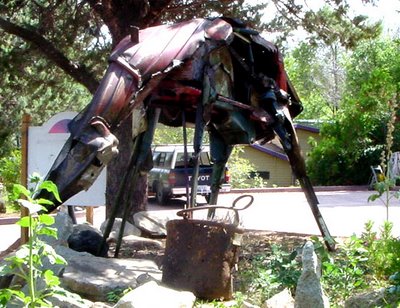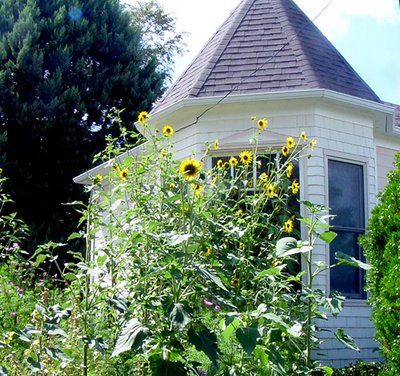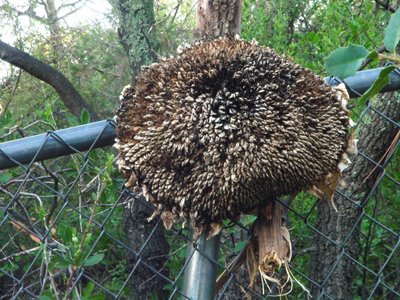
What's to be seen on an afternoon's walk? Sights that range from the sublime (seed pod, above) to the, well, mundane problems of every day living (below.)

To report: the weather was springlike; the locale, two alleys and Grove Avenue. (I've always wondered about that name -- was it descriptive of beautiful old trees long gone for wider streets or was it dedicated to a city father (or land developer)?

There was this sign on an alley door; particularly poignant to one who spent her school years in Jacksonville, Florida, where the Seaboard was an important institution.

And, just beyond an alley fence, a tree the surgeons had thoroughly lollypopped. Yet come summer, it will be leafy green and no one will be the wiser.

At the credit union over on Grove Street, the landscape gravel had been carefully raked and carelessly walked upon. But the circle was deliberate. A first cousin of graffiti, I'd say.

I finally got reasonably good pictures of Gene Galazan's latest junkyard horses, part of the recent landscaping at Prescott College. More details in a later post.

Between the sidewalk and the pavement, rocks describe a small watercourse -- the land is slanting toward Butte Creek here.

OK, I couldn't resist doing an arty shot. In fact, I made several pictures of similar plants.

One of the nice things I've discovered about citified aspens is that graffiti artists leave them alone. No initials or hearts -- or historic carvings by Basque shepherds -- on these young trees over at Prescott College.

Now here's something you don't see very often in a mountain town -- an ultra-lightweight racing bike. The standard Prescott bicycle has a beefy frame and fat tires, the better to cope with rocky mountain trails hereabouts.

Which mountains still keep Butte Creek running nicely.

At the CVS drug store on Miller Valley, spring has been declared. I couldn't figure out what purpose the items above serve except to transmit colored light. The plastic angels, of course, are for this year's garden.


I'm more inclined to rely on the ravens than a drugstore marketing man to tell me when spring is on the way. This pair was billing and cooing on a high lamppost; can you imagine these big, raucous birds as a romantic couple? I would expect that the courthouse ravens are already nesting, by the way.
 Don't know when this new sculpture first made its appearance at the entrance to Yavapai College, but it certainly wasn't there when I visited the school's sculpture garden last fall. I breakfast once a week at JBs with friends, which is why I discovered this very American Indian looking fellow; he's quite visible from Sheldon Street.
Don't know when this new sculpture first made its appearance at the entrance to Yavapai College, but it certainly wasn't there when I visited the school's sculpture garden last fall. I breakfast once a week at JBs with friends, which is why I discovered this very American Indian looking fellow; he's quite visible from Sheldon Street. A closer look at the sculpture.
A closer look at the sculpture. I had assumed that this was strictly metal work, but a zoom-in reveals that the center post is wooden. Can't furnish any details as to the sculptor's name or studio or location -- I tried The Google, but no dice. My fault. If I were to produce my posts during the day, instead of late evening, I could simply ring up the PR department at the college and ask.
I had assumed that this was strictly metal work, but a zoom-in reveals that the center post is wooden. Can't furnish any details as to the sculptor's name or studio or location -- I tried The Google, but no dice. My fault. If I were to produce my posts during the day, instead of late evening, I could simply ring up the PR department at the college and ask.


































